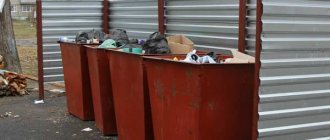Removal of bulky and construction waste raises questions
The main questions that arise in relation to bulky and construction waste boil down to:
- is construction waste included in the concept of “bulk waste”;
- Is bulky and construction waste considered municipal solid waste?
- where such waste should be stored and accumulated;
- who is responsible for the removal of KGM and construction waste;
- who and how pays for the services of transporting this waste to the disposal site.
Let's try to understand each of these issues separately, based on the regulations governing “garbage reform” and the management of apartment buildings.
Who is a MSW management operator and what does he do?
440255
Where and how to throw it away?
According to the law, in order to dispose of KGM, the tenant must contact the regional operator with an application for the provision of specialized cargo vehicles. This service is paid.
The coordinates of the service can be clarified with the management company, housing and communal services, or with the management of the HOA. You can also find out the location of the nearest waste disposal site and take the waste there yourself.
Bulky waste does not fit into containers
The current regulations have several similar definitions of what bulky garbage or waste is (KGM or KGO). Thus, in paragraph 2 of the Decree of the Government of the Russian Federation dated November 12, 2016 No. 1156, bulky waste includes municipal solid waste of such a size that it cannot be placed in containers, for example, furniture or household appliances.
GOST R 56195-2014 provides a more specific definition of CGO as production and consumption waste. These are items that have lost their consumer properties. The dimensions of such objects exceed 0.5 meters in height, width and length.
There is another definition that companies providing waste removal services refer to: KGM is waste that cannot be compressed and transported in a compacting garbage truck.
Who posts information about the MSW management service in the Housing Information System?
171364
What do the terms KGM and MSW mean?
Solid waste is a legally approved term for waste that can be placed in a trash can. It can be compressed and fits into regular garbage trucks. In regulatory documents, in some cases, instead of solid waste, the term MSW is indicated, that is, municipal solid waste instead of similar household waste.
The term KGO (bulk waste) is sometimes replaced by the abbreviation KGM. This category includes items that are not suitable for use, the list of which is confirmed by the above-mentioned 2021 resolution.
KGM is included in household waste and is removed by the recycler
According to clause 12 of RF PP No. 1156, the removal of bulky waste is the responsibility of the regional operator. He is obliged to do this, including at the request of consumers.
Storage of CGO for export, in accordance with clause 11 of RF Regulation No. 1156, is allowed in bunkers installed on container sites or in specially designated areas. They must be specified in the contract with the regional operator for the provision of MSW management services. The contract also specifies a schedule for the removal of bulky waste.
Consequently, bulky waste is included in the concept of “solid municipal waste” and responsibility for its removal and transportation lies with the MSW management operator selected in the region. This is also recorded in clause 7.1 of GOST R 56195-2014.
The cost of removal of bulky waste must be included in the standard established in the region for payment of the services of the regional operator for the management of municipal solid waste. There should be no additional payment for the removal of waste goods.
About value added tax for MSW management services
118651
Special containers
Large containers intended for KGM are installed on the basis of obligations established by a contract previously concluded with the operator in areas where large-sized waste constantly appears. Most often, special containers are placed near new buildings. The volume of a large container can be from 8 to 32 cubic meters. m.
In accordance with clause 3.7.2 of Resolution No. 170 of the State Construction Committee, as a non-permanent measure, the construction of a bunker for cargo and waste goods, as well as removable wooden containers equipped with hatches for loading, is permitted.
To install a special container, choose an entrance convenient for parking and loading a large cargo vehicle. Removal is carried out as full, at least once every 7 days. There are no requirements for the surface on which the container will be placed. Installation on the ground is allowed.
In megacities, the problem is particularly solved by handing over old furniture to special points as part of the Dump project for money.
Construction debris can damage a garbage truck
Construction waste is often also classified as bulky waste, because it meets the characteristics of this type of MSW: it does not fit into a standard container, and cannot be compressed and transported by a regular garbage truck. At the same time, as a rule, construction waste is heavy and sometimes poses a danger to human health.
Construction waste is all waste that is generated during dismantling, repair or construction in an apartment building. This is not only concrete, bricks, pieces of metal, but also dismantled doors and windows, removed linoleum, old wallpaper, etc. It can be divided into:
- directly construction waste,
- packaging materials,
- Decoration Materials.
The responsibilities of the regional waste management operator do not include the removal of this type of waste. Responsibility for this lies with the persons during whose activities such waste was generated.
Removal and disposal of such waste must be carried out separately from MSW. For violation of this rule, administrative liability is provided under Art. 8.1 Code of Administrative Offenses of the Russian Federation.
Who should clean the container site on a registered MKD site?
11138518
Sorting and recycling
The operator of this region, using heavy-duty transport, delivers the KGM to the landfill or marshalling station. The volume of incoming waste is determined by weighing or by cubic meters.
The waste undergoes manual sorting in order to select materials suitable for reuse. During the sorting process, the following are separated:
- different types of paper, glass and plastic;
- scrap metal and non-ferrous metals;
- precious metals extracted from electronic circuit boards of household appliances;
- whole things, clothing and computer equipment;
- wood.
Then they are disposed of by grinding and mechanical sorting. The technological process is aimed at reducing the volume of landfills and helps reduce the negative impact on the environment. Sorting and recycling of waste also reduces the cost of primary raw materials.
Construction waste is removed by specialized companies under a separate agreement
Construction waste is prohibited from being placed in containers for solid waste: such waste, even if it could fit into bins installed for household waste, can damage garbage trucks during loading and transportation (clause 14 of RF Regulation No. 1156). Some of this waste may pose a danger to humans and the environment, including due to construction dust.
Specialized companies, including regional MSW management operators, are engaged in the collection and removal of construction waste for a fee, since this waste is not included in the approved waste management standard.
If one of the residents in an apartment building starts repairs, then he does not have the right to remove and place the resulting construction waste on the container site. He is obliged, either himself or through a management organization, to contact a company that specializes in the removal of this type of waste and enter into an agreement with it for waste removal.
Fine and sanctions for incorrect emission
Throwing large-sized garbage into standard bins located near the house, or stacking it nearby, entails punishment under the Code of Administrative Offenses of the Russian Federation (Article 8.1).
For civilians, a fine of up to 2 thousand is provided, for officials - up to 5 thousand, and for legal entities - up to 100 thousand rubles.
Payment of a fine does not relieve the violator from the obligation to pay for the transportation of KGM left by him in the prohibited territory. The regional operator carrying out the removal of MSW on the basis of a contract is responsible only after receiving and loading the waste into a special vehicle. Until this moment, the responsibility for maintaining areas with containers and specialized sites lies with the resident, management company or HOA, in the case where the responsibilities have passed to them.
The decision on centralized removal of construction waste is made at the OSS
Another option: if the renovation is carried out by several owners at once or almost all of them, for example, in a new building. In such houses, spontaneous dumps of construction waste are formed.
In this case, the organization managing the house, if one has already been selected, or the owners themselves can enter into an agreement for the removal of construction waste, defining a place for waste collection and a removal schedule. The selected company installs a special open container for construction waste, where residents of the house are required to place construction waste.
Container for storing construction waste
At the same time, at the general meeting, the owners must approve the inclusion of a fee for this service in the fee for the maintenance of residential premises or as a separate line for the residential service of removing construction waste, as well as approve the amount of the fee for it. In this case, the owners who have more than 50% of the number of votes of the OSS participants must vote for the additional service (Part 1, Article 46 of the RF Housing Code, Part 7, Article 156 of the RF Housing Code).
Removal cost
The cost of the KGM removal service depends on the capacity of the transport involved.
In Moscow and the Moscow region, prices were set at:
- cargo van "GAZ" with a carrying capacity of 1.5 tons: from 4 thousand rubles;
- container with a capacity of 8 cubic meters. m: from 6.8 thousand rubles;
- container 20 cubic meters m: from 20 thousand rubles;
- container 27 cubic meters m: from 22 thousand rubles.
Prices for one-time services are given.
Important to remember
Management organizations and homeowners' associations, as well as residents of apartment buildings, must separate the concepts of household bulk waste and construction/repair waste.
Household bulky waste is included in MSW, and the regional operator is responsible for its removal. The fee for the removal of KGM is included in the tariffs and standards of the selected re-operator.
Construction waste does not belong to MSW and is not included in the area of responsibility of the utility service provider for the management of municipal solid waste. Its removal is carried out under a separate agreement with a transport operator or other specialized company for an additional fee.
At the same time, the management organization or HOA must monitor order at container sites if they are located on a land plot included in the common property of an apartment building.
Therefore, the management authority should inform residents of the building about the procedure and location for storing bulky waste, the schedule for its removal, as well as how they should dispose of construction waste.
What is the problem with garbage disposal after renovation?
The problem is that the regional operator does not classify such waste as MSW.
Those people who entered into contracts with construction companies did not really wonder where to take out construction waste on their own. All work, including waste disposal, was undertaken by the builders. In some cases, you had to pay extra for this, in others, this service was provided as a bonus.
But in other cases, if the repairs are done independently or specialists working semi-legally are ordered (including citizens of Ukraine, Moldova, Tajikistan or Uzbekistan), taking out the garbage after renovating the apartment becomes a problem.
At best, they will take this waste out of town, at worst, they will leave it in the apartment or take it to a site with containers near an apartment building. The result is that illegal immigrants (or people in a semi-legal position without the right to work) will come to the attention of the employees of the management company, they will call the migration service and subsequently draw up a report on the owner of the apartment on violation of migration legislation.
In general, it is better to immediately try to resolve the issue legally. This means you will have to call the regional operator and negotiate.
How much it costs to remove construction waste depends on its quantity, region, and operator tariffs. It may cost 500 rubles, or it may require 10-15 rubles. and more.
Current problems in the fight against landfills
Garbage is a product of civilization. It has existed since the transformation of the ape into homo sapiens. But in ancient times, waste was of organic origin and quickly decomposed. With the advent of factories and factories, the invention of plastic, glass and other materials, the situation worsened.
For comparison: Food debris decomposes in 30 days, rubber in 150 years, plastic in 180 years, and an aluminum can in 500 years.
The standard of living rises, people's needs increase, and along with them the percentage of waste produced per person increases. The increase in landfills per year is 0.4 million hectares.
The situation is further aggravated by the fact that only 4% of all waste is sent to recycling facilities. This is due to several reasons:
- Lack of specialized places for disposal.
- Insufficient funds for processing.
- Outdated processing technologies.
- Lack of sorting of household waste.
That is why the Garbage Reform was launched. Its goal is to obtain finance for the construction of factories, equip them with innovative equipment, and facilitate the sorting of raw materials by introducing different containers for dry and wet waste.
Wet waste includes vegetable scraps and food residues. Dry - metal, plastic, glass, paper. The authorities believe that this innovation will increase the volume of disposal and recycling by 30%.
Rules for maintaining container sites
To avoid the inconvenience of using containers and littering the places where garbage cans are located, certain requirements are imposed on the maintenance of this area. They are prescribed in Government Decree No. 491 of 2006. The management company must:
- Monitor sanitary conditions and maintain established hygiene standards.
- Carry out periodic cleaning of the site and surrounding area.
- In winter, clear snow and ice, organize access for vehicles and approaches for residents.
- Monitor the timely removal of waste.
- Monitor the condition of containers. Clean tanks and repair them.
- Disinfect waste bins monthly.
According to sanitary requirements, the frequency of MSW removal should be at least 20 times a month. At air temperatures from -5 – once every 3 days. At temperatures above +5 - daily. If waste cleaning and transportation is carried out less frequently, the owner has the right to complain to the company providing the service.
Where can I complain about the Management Company?
Unfortunately, the prescribed requirements are not always met. If you constantly observe unsanitary conditions, an unpleasant odor, or a cluster of insects, the reason is most likely that the landfill is not clean enough.
In such cases, violations should be reported. You can contact various organizations:
- Directly to the Criminal Code.
- Emergency dispatch service.
- City Housing Inspectorate.
- Local administration.
If measures have not been taken at the municipal level, the consumer has the right to write about a violation of sanitary and epidemiological standards to Rospotrebnadzor or the Prosecutor's Office. It is advisable to take a photograph of the place where the garbage accumulates and draw up a report listing the claims and indicating the violation of the cleaning deadlines.
Responsibility of the parties: improving the environment together
The global nature of the problem has long attracted the attention of the authorities. But it is impossible to solve it alone, with the help of one organization. Therefore, various organizations are involved in establishing order:
- local authorities;
- management companies, homeowners associations;
- regional operators.
Each of them has its own area of responsibility.
Organization of waste sites
Local governments are required to organize container sites. They must have a concrete or asphalt surface with a slope for more comfortable movement of garbage cans, a curb fence around the perimeter, and an access road for vehicles (the requirements are regulated by SanPiN 2.1.2.2645-10). Garbage sites must be located at least 20 meters away from residential buildings, sports and children's playgrounds, and recreation areas. The maximum number of containers is 5.
In addition, local authorities are developing location plans and registers of places with all technical characteristics.
Which organization should clean up trash in the yard?
The local area adjacent to high-rise buildings is the property of all residents of the building. Cleaning work is carried out by management companies or third-party service companies with which the HOA members have entered into an agreement. They not only sweep, but also water the plants, bring in sand, paint and repair small architectural forms.
Their responsibilities include ensuring order at garbage sites. They must monitor their cleanliness, the integrity of fences and containers, the presence of lighting and equipment access to the tanks.
The list of works was approved by Government Decree No. 290 of 2013. Compliance with these requirements is checked by the local administration and Rospotrebnadzor.
If you are dissatisfied with the quality of cleaning, you can write a complaint to local authorities, who are required to conduct an inspection within 5 working days. For non-compliance with the Code of Administrative Offenses (Article 6.4), it provides for punishment.
For officials, a fine of 2,000 rubles, for organizations – 20,000 rubles. In some cases, the court may suspend the activities of the Criminal Code for 90 days.
Collection, removal and disposal: who is responsible?
Regional operators are responsible for the management of MSW. They are required to install containers for dry and wet waste. Garbage trucks must be equipped with weight sensors and GPS beacons. This measure is aimed at preventing the formation of spontaneous landfills. Such gadgets allow you to control the movement of waste to disposal sites.
The operator is not obliged to clean container sites (Government Decree No. 1156 of 2021). Responsibility begins only from the moment the container is unloaded. But, if the waste was spilled due to the fault of the reclaimer, the workers are obliged to remove it and leave the place clean. Also, if the removal schedule is violated, responsibility for cleaning the area where the bunkers are located, within a radius of 4 meters, rests with the MSW management company.
Responsibility of apartment owners
Apartment owners are required to pay timely fees for services provided. If this requirement is violated, the regional operator may require payment of a penalty, the amount of which will be 1/130 of the Central Bank key rate of the amount owed for each day of delay.
Let's talk about payment
Since the service has become a public service, its calculation is made in accordance with Article 157 of the Housing Code. It states: the amount is determined based on the volume of services consumed, determined by metering devices. In the absence of such standards, MSW accumulation standards are taken as a basis.
Calculations are carried out using the formula: annual cost = RT * НН*n*, where:
- RT – regional tariff. That is, the amount at which the operator estimates 1 cubic meter of garbage in rubles. Installed by agreement with the administration.
- NN – accumulation standard. This is the volume of garbage per year (measured in cubic meters), which accumulates as a result of the life activity of one person living in an apartment building.
- n* – number of residents in the apartment. If no one lives in the living space, the number of registered citizens is taken into account.
And by dividing the resulting product by 12, you can find out the cost of the service per month.
Accumulation standards are established by local governments. Tariffs – by regional operators.
More about tariffs
When setting the tariff, several factors are taken into account:
- Separate collection and sorting of solid waste.
- Distance to disposal site or recycling facility.
- Neutralization, disposal of waste.
- Fuel prices.
- Maintenance of contracts with processing plants.
- Features of the climate.
The established amount should be enough to cover numerous expenses: VAT, to ensure the administrative activities of the operator, to eliminate the negative impact on the ecosystem.
The new export tariffs significantly exceed the previously existing ones and have different values for each region.
On average, the situation today looks like this.
| Region | Tariff per person (value is given rounded in rubles) |
| Nizhny Novgorod Region | 171 |
| Voronezh | 165 |
| Sverdlovskaya | 149 |
| Volgogradskaya | 115 |
| Tomsk | 106 |
| Novosibirsk | 92 |
| Krasnoyarsk region | 83 |
| Astrakhan | 96 |
| Kursk | 71 |
In some regions (Kaluga, Irkutsk, Tyumen regions) the fee for 1 sq. m. meter. In others (Transbaikalia, Khabarovsk Territory, Omsk Region), the introduction of innovations has been postponed for now. But in most of Russia, accruals are carried out according to a new formula.
A few words about standards
The definition of savings rates is determined by Government Decree No. 249 of 2021. This indicator is influenced by several parameters:
- Availability of communication systems: water and gas supply, sewerage, heating.
- Floors of the house.
- The presence of a garbage chute.
- Welfare of owners.
- Climatic and natural conditions.
In a certain territorial unit, measurements and weighing of waste are carried out to establish an accounting unit. This is required by Federal legislation and the Order of the Ministry of Construction dated July 28, 2016.
On average, the rate of waste accumulation per person is 2-2.5 cubic meters. meters per year.
This indicator is very important, since the size of the tariff, the frequency of removal, and the determination of the number of transport units involved in the transportation of waste depend on it.
Values for different regions may vary significantly.
| Region | Annual norm in kg | Annual norm in cubic meters |
| Voronezh region | 419,71 | 3,355 |
| Sverdlovskaya | 403,032 | 2,028 |
| Kamchatka | 567,36 | 2,856 |
| Kursk | 285 | 1,5 |
| Kurganskaya | 234,8 | 1,7 |
| Volgogradskaya | 421,44 | 2,5 |
| Crimea (Simferopol) | 404,55 | 2,9 |
| Krasnodar region | 415,8 | 2,31 |
| Omsk | 292,2 | 2,16 |
Changes in 2021
In addition to changing the status of the service, there are several other innovations:
- Local governments are responsible for the formation of landfills and the selection of an operator for each region on a competitive basis.
- Now the amount of payment depends not on the area of housing, but on the number of residents living in the apartment.
- The payment includes transportation costs.
- Separate waste collection to facilitate disposal or obtain secondary raw materials. Benefits are provided for participation in the waste distribution program for food and non-food. Their size can reach 50% (but not more) of the total amount.
These changes form the essence of the Waste Reform, which is designed to eliminate problems associated with the collection and disposal of waste. The funds received are expected to be used for the construction of processing plants.




